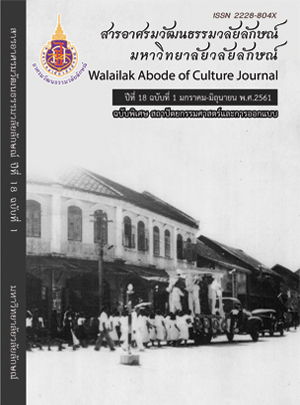The Study Materials Designed Interior with Rubber Leaves
Main Article Content
Abstract
The purposes of this research were to collect data on the benefits of rubber leaves for a guide in the production of building materials; to use as a design to develop a model to support the interior of the building. The process of studying information, documents, textbooks and survey about raw materials. There are 2 ways to processed rubber leaves products: The first form; fermented soaked in 3 months. The second form; boiled in caustic soda with water, 5 liters of water per 500 g of caustic soda, boiled for 3 hours, temperature is fixed at 100 ° C. Materials testing can be divided into 3 ways: The first form; use rubber latex. The second form; use water-based adhesive. The third form; use polyurethane. The experiment found that the second method is suitable for further development.
The research found that; It was found that most of them were used to fabricate flowers, butterflies, lamps, Soap wrapping paper from rubber leaf tissue. The collected data on the benefits of the leaves of rubber for a guide in the production of building materials. Design the scene from rubber leaves, use water-based adhesive as a binder lead to the air can be adequately ventilated and flexible the surface is the closest to nature.
Article Details
© 2018 by Asian Journal of Arts and Culture, Walailak University. All rights reserved.
References
Jankong, J. (2015). Kan wikhro phonlaka rodam nœn ngan tam lak pratya setthakit pho̜phiang Khong samachik klum hatthakam dokmai yangphara hu rae [A performance analysis of a sufficiency economy philosophy practice of the handicraft maker’s group in Hu-Rae]. RMUTP Research Journal Special Issue ,The 5th Rajamangala University of Technology National Conference, pp. 59-66.
Phisudsiang, C. (2010). Prasitthiphap kan prayat phalangngan khong chanuan bai yangphara [Energy - Efficient of insulation produced from rubber leaf]. (Master’s Thesis, Chulalongkorn University).
Saelee, S. & Sikkha, S. (2012). Kansuksa krabuankan phalit lae sombat khong phae nafa lae phanang chanuan kan khwam ron chak phut nai khet phunthi prathet thai [The Development of Insulating Ceiling Boards and Wallsfrom Plants in Thailand]. Art and Architecture Journal Naresuan, 3(1), 15-24.
Sangrutsamee, V. (2012). Watsadu toktaeng lae fenichœ chak yua kradat luachai thang luak mai [Decorative Products and Furniture from Newly Developed RecycledPaper Pulp]. Pathum Thani: Faculty of Architecture, Rajamangala University of Technology Thanyaburi.
Suybangdum, P. et al. (2007). Kanphalit lae phatthanakara dat chak bai sapparot phua chai kan banchuphan samrap sinkha nung tambon nung phalittaphan nai chumchon muban pa bak tambon pa bak amphoe pa bon changwat Phatthalung [Paper production and development from pineapple leaves touse the packaging for one Tambon one product in the community. Pa Sak Village, Pa Sak, Pa Bon, Phatthalung]. Bangkok: Office of the Higher Education Commission.
Thongmit, S. et al. (1997). Kanphalit yua kradat chak nua yua bai yang [Tissue Paper Production from Rubber Leaves Tissue]. Rubber Research Report.


